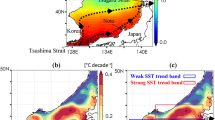Abstract.
A two-dimensional, three-basin ocean model suitable for long-term climate studies is developed. The model is based on the zonally averaged form of the primitive equations written in spherical coordinates. The east–west density difference which arises upon averaging the momentum equations is taken to be proportional to the meridional density gradient. Lateral exchanges of heat and salt between the basins are explicitly resolved. Moreover, the model includes bottom topography and has representations of the Arctic Ocean and of the Weddell and Ross seas. Under realistic restoring boundary conditions, the model reproduces the global conveyor belt: deep water is formed in the Atlantic between 60 and 70° N at a rate of about 17 Sv (1 Sv=106 m3 s–1) and in the vicinity of the Antarctic continent, while the Indian and Pacific basins show broad upwelling. Superimposed on this thermohaline circulation are vigorous wind-driven cells in the upper thermocline. The simulated temperature and salinity fields and the computed meridional heat transport compare reasonably well with the observational estimates. When mixed boundary conditions (i.e., a restoring condition on sea-surface temperature and flux condition on sea-surface salinity) are applied, the model exhibits an irregular behavior before reaching a steady state characterized by self-sustained oscillations of 8.5-y period. The conveyor-belt circulation always results at this stage. A series of perturbation experiments illustrates the ability of the model to reproduce different steady-state circulations under mixed boundary conditions. Finally, the model sensitivity to various factors is examined. This sensitivity study reveals that the bottom topography and the presence of a submarine meridional ridge in the zone of the Drake Passage play a crucial role in determining the properties of the model bottom-water masses. The importance of the seasonality of the surface forcing is also stressed.
Similar content being viewed by others
Author information
Authors and Affiliations
Additional information
Received: 23 September 1993/Accepted: 26 April 1994
Rights and permissions
About this article
Cite this article
Hovine, S., Fichefet, T. A zonally averaged, three-basin ocean circulation model for climate studies. Climate Dynamics 10, 313–332 (1994). https://doi.org/10.1007/s003820050051
Issue Date:
DOI: https://doi.org/10.1007/s003820050051




